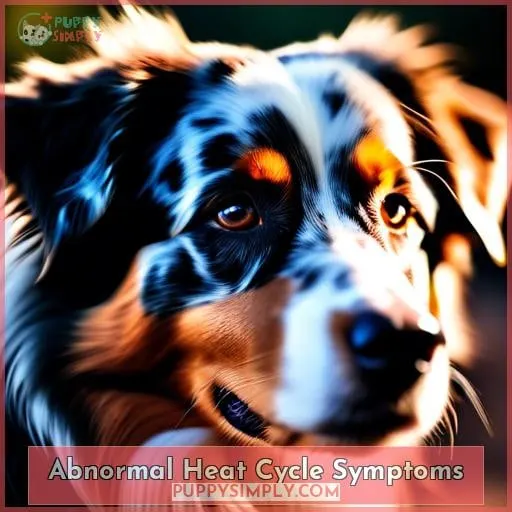This site is supported by our readers. We may earn a commission, at no cost to you, if you purchase through links.
 Do you have an Australian Shepherd? If so, you’ll want to understand their heat cycles.
Do you have an Australian Shepherd? If so, you’ll want to understand their heat cycles.
We’ll delve into:
- The frequency of heat cycles
- The stages of heat cycles
- Abnormal symptoms associated with heat cycles in Australian Shepherds
With this knowledge, you can ensure your furry friend’s reproductive health and well-being.
Table Of Contents
- Key Takeaways
- Heat Cycle in Australian Shepherds
- Signs and Symptoms of Heat
- How Often Do Heat Cycles Occur?
- Heat Cycle Stages
- Abnormal Heat Cycle Symptoms
- Spaying Considerations
- When Does Heat Start?
- Frequently Asked Questions (FAQs)
- Is it normal for an Australian Shepherd to experience silent heat cycles?
- Can an Australian Shepherd go into heat more than twice a year?
- What are the potential health risks associated with spaying an Australian Shepherd before their first heat cycle?
- Are there any natural remedies or supplements that can help regulate an Australian Shepherd’s heat cycle?
- Can Australian Shepherds experience menopause like humans do?
- Conclusion
Key Takeaways
- Australian Shepherds typically start their heat cycles between 6-9 months.
- The heat cycle consists of four stages: proestrus, estrus, diestrus, and anestrus, which can last for 2 weeks to 1 month.
- Abnormal symptoms during heat, such as thick discharge, increased thirst, or behavioral changes, require veterinary attention.
- Spaying can eliminate unwanted pregnancies, reduce cancer risks, and should be considered around 6 months of age or after full growth.
Heat Cycle in Australian Shepherds
Understanding your Australian Shepherd’s heat cycle requires awareness of its stages, signs, and frequency.
Heat cycles, influenced by breed and individual factors, typically start between 6 and 9 months, with variations possible. Nutritional and exercise choices can subtly impact onset timing. Delayed cycles may signal underlying health issues or hormonal imbalances, warranting veterinary attention.
Heat cycles comprise four stages: proestrus, estrus, diestrus, and anestrus.
Proestrus marks the onset of bleeding and vulva swelling.
Estrus, the fertile phase, is characterized by straw-colored discharge and receptiveness to mating.
Diestrus, the longest stage, follows mating or lasts about two months if no mating occurs.
Anestrus is the resting phase until the cycle restarts.
Abnormal symptoms during heat, such as foul-smelling discharge, excessive bleeding, or behavioral changes, demand veterinary attention.
Spaying, while offering health benefits, is a personal choice influenced by factors like age, breeding plans, and potential risks.
Signs and Symptoms of Heat
As an Australian Shepherd owner, it’s crucial to recognize the signs of heat, which typically include:
- Swollen and red vulva
- Increased urination
- Bloody discharge
Heat cycles can last anywhere from 2 weeks to 1 month, so you’ll need to take steps to manage your dog’s behavior and prevent unwanted pregnancies during this time.
Signs of Heat Cycle
You’ll notice signs of your Australian Shepherd’s heat cycle, including:
- A swollen and red vulva
- Increased urination
- Bloody discharge
- Behavioral changes like restlessness and increased affection
Australian Shepherds typically experience their first heat cycle between 6 and 9 months of age, but this can vary depending on their health, nutrition, and environment.
Heat Cycle Duration
How long can you expect your Australian Shepherd’s heat cycle to last?
It generally spans 2 to 3 weeks, but variations occur.
| Cycle Phase | Duration | Hormonal Influences |
|---|---|---|
| Proestrus | 3-9 days | Estrogen dominant, vulva swelling |
| Estrus | 6-12 days | Progesterone dominant, receptive to mating |
| Diestrus | 60-90 days | Progesterone declines, uterine lining thickens |
Heat cycles offer insights into your dog’s reproductive health.
Consult your veterinarian if you notice irregularities.
Abnormal Symptoms
When might you notice abnormal symptoms during your Australian Shepherd’s heat cycle?
Vigilance is key to spotting signs of pyometra, a life-threatening uterine infection.
Watch for:
- Thick, pus-like discharge
- Increased thirst
- Decreased appetite
Early detection is crucial, so seek veterinary intervention at the first sign of trouble.
How Often Do Heat Cycles Occur?
Moving on to frequency, Australian Shepherds typically experience heat cycles twice a year, though this can vary.
Heat cycle frequency is influenced by:
- Hormonal factors
- Environmental conditions
- Genetic predispositions
Younger dogs tend to have shorter cycles, while older dogs may experience longer intervals between cycles.
Understanding heat cycle frequency is crucial for:
- Responsible breeding practices
- Preventing unwanted pregnancies
- Ensuring the well-being of your furry companion
Environmental factors such as nutrition, exercise, and stress levels can also impact the regularity of heat cycles.
Additionally, some Australian Shepherds may exhibit silent heats, where they experience ovulation without the usual outward signs, making it challenging to predict their fertile periods.
Heat Cycle Stages
Now, let’s delve into the fascinating stages of an Australian Shepherd’s heat cycle.
It’s a journey marked by hormonal fluctuations that orchestrate a symphony of physiological changes.
The first stage, proestrus, signals the onset of the heat cycle.
You’ll notice a swelling of the vulva and a bloody vaginal discharge.
This stage typically lasts for a week, during which your furry companion may seem restless and attracted to male dogs.
Next comes estrus, the fertile phase.
The bloody discharge lightens in color, adopting a straw-like hue.
This is the time when your Australian Shepherd is most receptive to mating.
Her body is primed for reproduction, and her behavior reflects this readiness.
You may observe increased affection and a willingness to accept male advances.
Following estrus is diestrus, a period of either pregnancy or hormonal readjustment.
If your dog doesn’t conceive, her body embarks on a journey of hormonal rebalancing, preparing for the next cycle.
This stage can last for several weeks.
Finally, anestrus is the resting phase, a period of reproductive dormancy.
During this time, your dog’s body takes a break from the hormonal rollercoaster, conserving its energy for the next cycle.
Understanding these stages will help you navigate your Australian Shepherd’s heat cycles with ease and provide her with the care and support she needs.
Abnormal Heat Cycle Symptoms
You should recognize signs of abnormal heat cycles, such as pus-like discharge or a swollen vulva, which may indicate infections like pyometra.
Spaying your dog can prevent these infections and is recommended around 6 months before the first heat cycle or after the dog is fully grown.
Age can impact the frequency of heat cycles, with older dogs experiencing longer intervals between cycles.
Recognizing Abnormal Symptoms
Since abnormal heat cycle symptoms may arise, watch for signs of infection or illness, such as unusual discharge, fever, or lethargy.
Act promptly, seeking veterinary care to rule out hormonal imbalances or reproductive risks.
Treatment options vary depending on the underlying cause, but early intervention is crucial for your Australian Shepherd’s well-being.
Spaying for Prevention
To thwart pyometra’s possibility, spaying stands as the most effective preventive measure.
While it carries surgical risks, it also bestows health benefits like lowered cancer risks.
The ideal age for spaying remains a topic of debate, with some vets recommending it around 6 months and others preferring to wait till full growth.
Consulting your veterinarian is crucial to weigh the pros and cons and determine the best timing for your beloved Australian Shepherd.
Age-Related Considerations
Later on, you might notice that younger and older dogs are more susceptible to pregnancy complications during heat cycles.
Their bodies may not be fully developed or might face hormonal imbalances, leading to potential health implications.
Consulting your veterinarian is crucial to determine the best course of action for your furry companion, ensuring their well-being throughout their reproductive journey.
Spaying Considerations
When considering spaying your Australian Shepherd, discuss the pros and cons with your veterinarian.
Spaying before the first heat cycle, typically around 6 months of age, can reduce the risk of:
- Mammary cancer
- Ovarian cancer
- Pyometra, a potentially life-threatening infection of the uterus
Spaying at a later age, around 12 months, allows the dog to fully mature and may reduce the risk of certain health problems, such as hip dysplasia.
Spaying Pros and Cons
Now that we’ve covered abnormal symptoms, let’s examine spaying’s pros and cons:
Spaying eliminates unwanted pregnancies, reduces cancer risks, and curbs certain behavioral issues.
However, it’s a surgery with potential risks like infection, bleeding, and anesthesia complications.
Weigh the benefits and risks with your veterinarian to make an informed decision for your beloved Australian Shepherd.
Age of Spaying
Considering spaying your Australian Shepherd? Let’s discuss the best age for the procedure.
Early spaying, around 6 months, offers health benefits like cancer prevention. However, it may impact growth and hormonal balance.
Spaying later, around 12 months, reduces these risks but may increase the chances of heat-related health issues.
Weigh the pros and cons with your vet to choose the ideal age for your dog’s unique needs.
Veterinary Consultation
To determine the best spaying age for your Australian Shepherd, consult with your veterinarian.
They’ll evaluate:
- Your dog’s heat cycle history
- Reproductive health
- Hormonal profile
This comprehensive assessment helps tailor a spaying plan that aligns with your dog’s unique needs and fertility goals.
When Does Heat Start?
When can you anticipate your Australian Shepherd’s first heat cycle?
Generally, it commences between 6 and 18 months of age, averaging around 12 months.
However, early onset or delayed initiation is possible, influenced by a symphony of factors.
Early puberty, heralded by a precocious heat cycle, can be triggered by environmental cues, hormonal factors, and even the presence of other dogs.
Conversely, delayed heat cycles may stem from a young age, illness, stress, obesity, or hormonal imbalances.
Regardless of the timing, behavioral changes often accompany the heat cycle’s onset.
Your Australian Shepherd may exhibit increased affection, restlessness, and a heightened interest in male dogs.
These shifts in behavior serve as subtle cues, nudging you to prepare for the arrival of her first heat.
Understanding the intricacies of your Australian Shepherd’s heat cycle empowers you to provide optimal care during this transformative period.
Whether it’s the first cycle or a subsequent one, recognizing the signs and symptoms equips you to navigate this natural process with ease and confidence.
Frequently Asked Questions (FAQs)
Is it normal for an Australian Shepherd to experience silent heat cycles?
Silent heat cycles, where there’s ovulation without noticeable signs, can occur in Australian Shepherds, especially young dogs.
Monitor behavior for subtle cues.
Consult your vet if you suspect a silent heat.
Can an Australian Shepherd go into heat more than twice a year?
Yes, an Australian Shepherd can go into heat more than twice a year, although it’s less common.
Factors like age, health, and environment can influence the frequency of heat cycles.
If you notice irregularities, consult a veterinarian for guidance.
What are the potential health risks associated with spaying an Australian Shepherd before their first heat cycle?
Spaying before the first heat cycle? That’s like plucking a flower before it blooms.
You’ll miss its radiant colors and sweet fragrance, and so will your dog’s overall health.
Are there any natural remedies or supplements that can help regulate an Australian Shepherd’s heat cycle?
Natural remedies or supplements may offer limited influence on regulating your Australian Shepherd’s heat cycle.
Consult your veterinarian for guidance on managing your dog’s reproductive health.
Can Australian Shepherds experience menopause like humans do?
Australian Shepherds, unlike humans, do not experience menopause.
Their heat cycles continue throughout their reproductive lifespan, typically starting around 6-12 months of age.
These cycles recur every 6-12 months.
Conclusion
Understanding your Australian Shepherd’s heat cycles is crucial for their reproductive health.
Every six to nine months, your furry companion will experience this natural process, marked by distinct signs and stages.
Abnormal symptoms, such as prolonged or irregular cycles, may indicate underlying health issues.
Spaying remains a widely recommended option to prevent unwanted pregnancies, reduce the risk of reproductive cancers, and eliminate heat cycles altogether.
Consult your veterinarian to determine the best course of action for your Australian Shepherd’s well-being.













